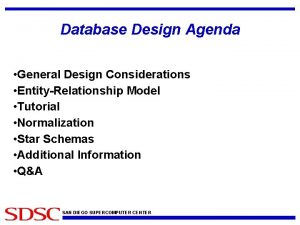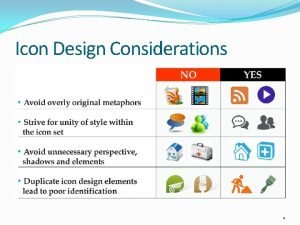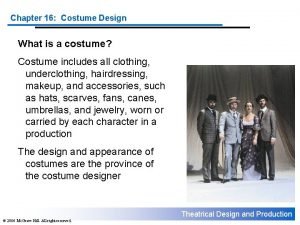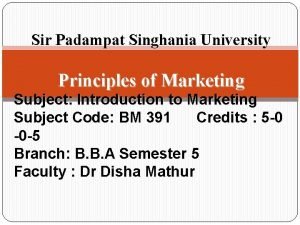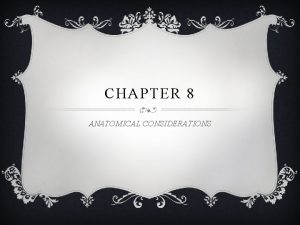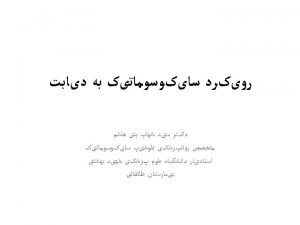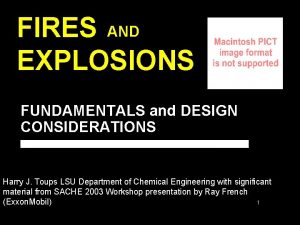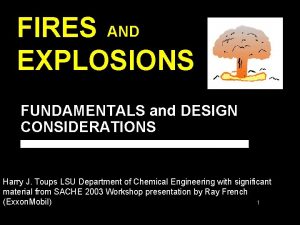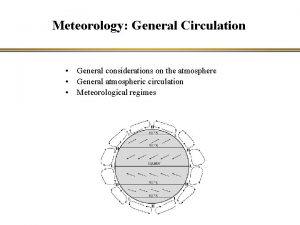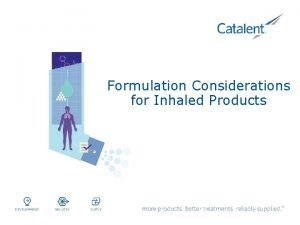Unit 2 Design Fundamentals Design General Considerations in



























- Slides: 27

Unit 2 Design Fundamentals (Design)

General Considerations in Machine Design 1. 2. 3. 4. 5. 6. 7. 8. 9. Type of load and stresses caused by the load. Motion of the parts or kinematics of the machine. Selection of materials. Form and size of the parts. Frictional resistance and lubrication. Convenient and economical features. Safety of operation. Cost of construction. Assembling.

General Procedure in Machine Design






Resilience. It is the property of a material to absorb energy and to resist shock and impact loads. It is measured by the amount of energy absorbed per unit volume within elastic limit. This property is essential for spring materials.

Classification of Engineering Materials The engineering materials are mainly classified as : 1. Metals and their alloys, such as iron, steel, copper, aluminum, etc. The metals may be further classified as : (a) Ferrous metals, and (b) Non-ferrous metals. The ferrous metals are those which have the iron as their main constituent, such as cast iron, wrought iron and steel. The non-ferrous metals are those which have a metal other than iron as their main constituent, such as copper, aluminum, brass, tin, zinc, etc. 2. Non-metals, such as glass, rubber, plastic, etc.







Non-metallic Materials 1. Plastics. The plastics are synthetic materials which are moulded into shape under pressure with or without the application of heat. 2. These can also be cast, rolled, extruded, laminated and machined. Following are the two types of plastics : (a) Thermosetting plastics, (phenolformaldehyde (Bakelite), phenol-furfural (Durite), ureaformaldehyde (Plaskon), etc. (b) Thermoplastic. = cellulose nitrate (Celluloid), polythene, polyvinyl acetate, polyvinyl chloride (P. V. C. ), 2. Rubber. It is one of the most important natural plastics. It resists abrasion, heat, strong alkalis and fairly strong acids. Soft rubber is used for electrical insulations. It is also used for power transmission belting, being applied to woven cotton or cotton cords as a base. The hard rubber is used for piping. 3. Leather. It is very flexible and can withstand considerable wear under suitable conditions. It is extensively used for power transmission belting and as a packing or as washers. 4. Ferrodo. It is a trade name given to asbestos lined with lead oxide. It is generally used as a friction lining for clutches and brakes.


Mechanical Properties of Metals 1. Strength. = It is the ability of a material to resist the externally applied forces without breaking or yielding. The internal resistance offered by a part to an externally applied force is called stress. 2. Stiffness. = It is the ability of a material to resist deformation under stress. The modulus of elasticity is the measure of stiffness. 3. Elasticity. = It is the property of a material to regain its original shape after deformation when the external forces are removed. 4. Plasticity. = It is property of a material which retains the deformation produced under load permanently. This property of the material is necessary forgings, in stamping images on coins and in ornamental work. 5. Ductility. = It is the property of a material enabling it to be drawn into wire with the application of a tensile force. The ductility is usually measured by the terms, percentage elongation and percentage reduction in area. The ductile material commonly used in engineering are mild steel, copper, aluminium, nickel, zinc, tin and lead.

6. Brittleness. It is the property of a material opposite to ductility. It is the property of breaking of a material with little permanent distortion. Brittle materials when subjected to tensile loads, snap off without giving any sensible elongation. Cast iron is a brittle material. 7. Malleability. It is a special case of ductility which permits materials to be rolled or hammered into thin sheets. A malleable material should be plastic but it is not essential to be so strong. The malleable materials commonly used in engineering practice (in order of diminishing malleability) are lead, soft steel, wrought iron, copper and aluminium. 8. Toughness. It is the property of a material to resist fracture due to high impact loads like hammer blows. The toughness of the material decreases when it is heated. It is measured by the amount of energy that a unit volume of the material has absorbed after being stressed upto the point of fracture. This property is desirable in parts subjected to shock and impact loads. 9. Machinability. It is the property of a material which refers to a relative case with which a material can be cut. The machinability of a material can be measured in a number of ways such as comparing the tool life for cutting different materials or thrust required to remove the material at some given rate or the energy required to remove a unit volume of the material. It may be noted that brass can be easily machined than steel.

10. Resilience. It is the property of a material to absorb energy and to resist shock and impact loads. It is measured by the amount of energy absorbed per unit volume within elastic limit. This property is essential for spring materials. 11. Creep. When a part is subjected to a constant stress at high temperature for a long period of time, it will undergo a slow and permanent deformation called creep. This property is considered in designing internal combustion engines, boilers and turbines. 12. Fatigue. When a material is subjected to repeated stresses, it fails at stresses below the yield point stresses. Such type of failure of a material is known as fatigue. The failure is caused by means of a progressive crack formation which are usually fine and of microscopic size. This property is considered in designing shafts, connecting rods, springs, gears, etc.

Cast Iron Ø The cast iron is obtained by re-melting pig iron with coke and limestone in a furnace known as cupola. Ø It is primarily an alloy of iron and carbon. Ø Since the cast iron is a brittle material, therefore, it cannot be used in those parts of machines which are subjected to shocks. Ø The properties of cast iron which make it a valuable material for engineering purposes are its low cost, good casting characteristics, high compressive strength, wear resistance and excellent machinability.

Steel It is an alloy of iron and carbon, with carbon content up to a maximum of 1. 5%. The carbon occurs in the form of iron carbide, because of its ability to increase the hardness and strength of the steel. Most of the steel produced now-a-days is plain carbon steel or simply carbon steel. APPLICATIONS It is used for plain drawn, tubes for oil well casing, steam, water and air passage, cycle, motor cycle and automobile tubes, rivet bars and wire. These steels are used for locomotive carriages and car structures, screw stock and other general engineering purposes. It is used for chemical pressure vessels nd other general engineering purposes. It is used for bridges and building construction, railway rolling stock, screw spikes, oil well casing, tube piles, and other general engineering purposes.

Non-ferrous Metals The non-ferrous metals are usually employed in industry due to the following characteristics 1. Ease of fabrication (casting, rolling, forging, welding and machining), 2. Resistance to corrosion, 3. Electrical and thermal conductivity, and 4. Weight. The various non-ferrous metals used in engineering practice are aluminium, copper, lead, tin, zinc, nickel, etc. and their alloys.

Aluminium • It is white metal produced by electrical processes from its oxide (alumina), which is prepared from a clayey mineral called bauxite. • It is a light metal having specific gravity 2. 7 and melting point 658°C. The tensile strength of the metal varies from 90 MPa to 150 MPa. • In its pure state, the metal would be weak and soft for most purposes, but when mixed with small amounts of other alloys, it becomes hard and rigid. • So, it may be blanked, formed, drawn, turned, cast, forged and die cast. • Its good electrical conductivity is an important property and is widely used for overhead cables. • The high resistance to corrosion and its non-toxicity makes it a useful metal for cooking utensils under ordinary condition and thin foils are used for wrapping food items. • It is extensively used in aircraft and automobile components where saving of weight is an advantage.

Copper • It is one of the most widely used non-ferrous metals in industry. It is a soft, malleable and ductile material with a reddish-brown appearance. • Its specific gravity is 8. 9 and melting point is 1083°C. • The tensile strength varies from 150 MPa to 400 MPa under different conditions. • It is a good conductor of electricity. • It is largely used in making electric cables and wires for electric machinery and appliances, in electrotyping and electroplating, in making coins and household utensils.

Copper-tin alloys (Bronze). • The alloys of copper and tin are usually termed as bronzes. • The useful range of composition is 75 to 95% copper and 5 to 25% tin. • The metal is comparatively hard, resists surface wear and can be shaped or rolled into wires, rods and sheets very easily. • In corrosion resistant properties, bronzes are superior to brasses.
 Durite
Durite Unit 6 review questions
Unit 6 review questions Database design considerations
Database design considerations Collaboration design considerations
Collaboration design considerations Biopharmaceutic considerations in drug product design
Biopharmaceutic considerations in drug product design Design considerations icon
Design considerations icon Ethical considerations in experimental research
Ethical considerations in experimental research Design considerations for mobile computing
Design considerations for mobile computing What is a costume
What is a costume Tax considerations for setting up a new business
Tax considerations for setting up a new business Emv kiosk considerations
Emv kiosk considerations Exchange transaction and relationship in marketing
Exchange transaction and relationship in marketing Mechanical design of transmission line
Mechanical design of transmission line Contrasting acquisition
Contrasting acquisition What is cloud delivery model
What is cloud delivery model Writing strategies and ethical considerations
Writing strategies and ethical considerations What is basal state in phlebotomy
What is basal state in phlebotomy Bioreactor considerations for animal cell culture
Bioreactor considerations for animal cell culture Fpd tooth preparation
Fpd tooth preparation Anatomical considerations
Anatomical considerations Mandibular impression landmarks
Mandibular impression landmarks Spa y dogso
Spa y dogso Acclimatisation pdhpe
Acclimatisation pdhpe Gastrectomy anesthesia considerations
Gastrectomy anesthesia considerations Capk expired debit card
Capk expired debit card Appendix in quantitative research
Appendix in quantitative research O2 mask types
O2 mask types Ethical considerations examples
Ethical considerations examples


